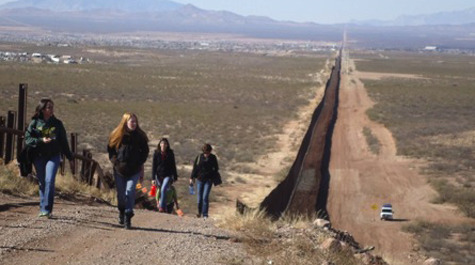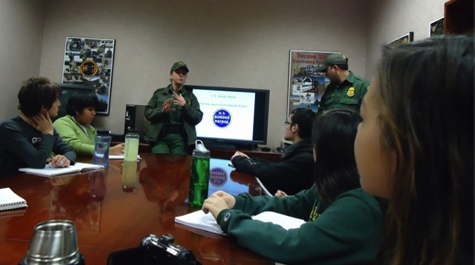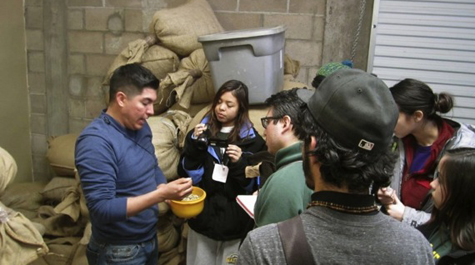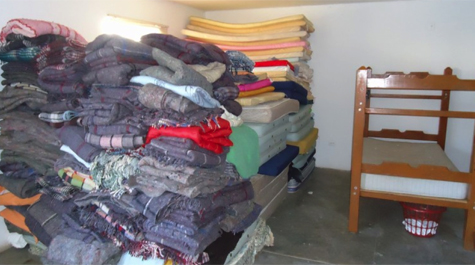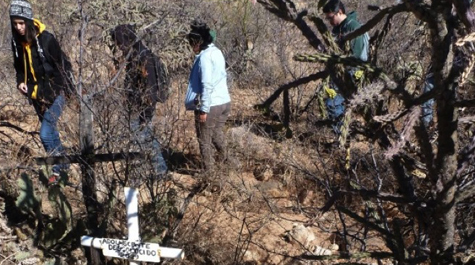As immigration takes center stage, students return from the border region
Two weeks before a group of bipartisan senators announced their blueprint to overhaul the nation’s immigration system, a group of William & Mary students spent part of their winter break on the U.S.–Mexico border immersed and enthralled in the human side of immigration.
Led by Associate Professor of Sociology and Director of the Latin American studies program Jennifer Bickham Mendez, an expert in Latino immigration, the William & Mary Borderlands project focuses on understanding our country’s current border issues. This is the fourth year of the program, which is open to all students. Robert Sanchez, a visiting assistant professor in philosophy, helped co-direct this year's program.
In early January, the group traveled to the border region of Tucson, Ariz., and Agua Prieta and Nogales, Mexico, an area that has become one of the most heavily trafficked and perilous crossing points between Mexico and the United States. There, they spoke to recently deported migrants awaiting transport to their home communities and listened to personal stories of why people were so desperately fleeing their country. They also met with humanitarian workers, faith-based organizations and advocates for immigrants on both sides of the border.
“What we heard over and over again from the people in the region is that ‘Washington doesn’t understand the border,’” said Mendez. “Everyone is very concerned – even fearful – of the new reform and the potential for heightened enforcement measures.”
Beefed up border enforcement is one area a group of senators included in an announcement on Monday that represented a sweeping overhaul of the immigration system. On Tuesday, President Barack Obama gave a speech in Las Vegas committing his full support to a comprehensive overhaul of immigration laws.
“I think most would agree that a path to citizenship is a reasonable and logical next step,” said Mendez. This action, said Mendez, will allow the estimated 11 million undocumented immigrates living in the U.S. to “come out of shadows and fully participate in this society without fear of deportation.”
“I’m not sure if we need more boots on the ground on the border… More helicopters, more sensors or more lights,” she added. “I think we need thoughtful reform that takes human rights into account.”
During the trip, the students also visited the Border Patrol headquarters and listened while an Immigration and Customs Enforcement agent outlined the dangers posed by drug cartels and human smugglers. The last stop was a walk in the desert in migrants’ footsteps to a shrine where a family of three had fallen victim to the dangers of the Sonoran desert.
Ashleigh Ramos ’13 was one of nine students who participated in the trip. She reflected on how she was moved by her experience.
"Our itinerary was packed, exhausting, and emotionally draining, but I felt thankful throughout for the opportunity to see the world from a different perspective, to hear voices from the borderlands that are too often silenced,” said Ramos.
Ramos continued, saying that most of the migrants she interacted with are “farmers like many of our great grandparents once were…. But for economic reasons they cannot finance their dreams from home.”
Having recently returned from the immersion experience, the group is doing what Mendez describes as “bringing the border back to the center” of U.S. policy and decision-making. In conjunction with the William & Mary Washington Office, a symposium entitled, “From the Border to the Center: Envisioning Compassionate Immigration Reform,” has been organized for April 19 from 12:30 – 5:30 p.m. at the Carnegie Building on DuPont Circle. Activists, scholars, practitioners and community members are invited, said Mendez, to participate in an open dialogue about immigration’s most pressing issues.
The symposium will consist of three panels introduced and moderated by William & Mary students who traveled to the border region. Ramos said she hopes that by sharing the group’s experiences, stories and insights intercultural understanding and a discussion toward comprehensive and compassionate immigration reform will take place.
“It [The William & Mary Borderlands Project] was such a profound and spiritual experience that even two weeks after the trip I am still processing everything I witnessed,” said Ramos.
“The experience will change you if you let it.”















